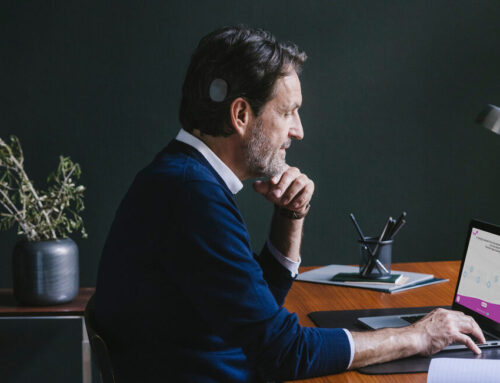Experience of CI users with different cochlear implants
The advantages of bimodal hearing can reach their full potential when hearing experience is in balance on both sides. This is why many CI candidates ask themselves whether they should have the same cochlear implant on both sides to achieve it.

Equal hearing impression on both ears makes it easier for the affected person to integrate these impressions into a common hearing sensation. This is true for bimodal fitting, with conventional hearing aids and hearing implants on the other side. But does this also apply to bilateral use of cochlear implants?
“Even people without hearing implants usually have an asymmetrical hearing organ,” says Prof. Dr. Wolf-Dieter Baumgartner, CIA president and CI surgeon at Vienna General Hospital. “That is not a problem for the brain and it compensates for such asymmetries entirely.”
Synchronize or optimize?
The introduction of a new implant, which is always a bit different from a previous model, has led to many bilateral CI users who have different implants on both sides. Also, different anatomical structures led to the use of different electrode lengths. The comparison of technical data and local services, together with the experience that the CI users already have from the implants on the first side, sometimes leads the users to switch deliberately to an implant from the Austrian manufacturer MED-EL.
“We can offer electrodes of different lenghts for our implants, even as short as those of other manufacturers. And we can, of course, also deactivate our unique fine structure coding”, Ewald Thurner, Area Manager at MED-EL Vienna, explains how different cochlear implants can be compared. “However, it has been shown in practice that users benefit most, when optimal electrode and coding are the crucial criteria for the choice of second CI.”
Comparison of Cochlear Implants from Different Manufacturers
As a result of Usher syndrome, Australian Grace Dimer* was functionally deaf on both sides and her vision was severely impaired. When she received her first cochlear implant in November 2004, she was already 63 years old. She got a modern cochlear implant from the Australian CI manufacturer Cochlear. Less than four years later, the clinicians at the Royal Prince Alfred Hospital in Camperdown suggested she get a CI for the second side as well. “Since 2008, our department has been using implants from both MED-EL and Cochlear Corporation,” the clinicians explain. After the close comparison of the two implants and careful consideration, Dimer chose the MED-EL implant. However, this was a new medical territory for the physicians in charge: “She is the first documented patient to be fitted bilaterally with cochlear implants from two different manufacturers.”
Three months later, Grace could already understand sentences with the MED-EL CI almost the same as with the old implant on the other side. After one year of bilateral hearing experience, understanding in noise was significantly better with both implants.
Experience says: Austrian Technology Sounds Better
“Hearing is subjective and individual experience, which is why it is precious to have a patient who can really directly decribe the difference between the implants”, the clinicians add. Grace described the sound of MED-EL implants as more natural, just six weeks after the activation of the implant. Besides, her friends added that she speeks more naturally as well! “Just like the difference between tuning a piano versus playing it,” she describes the sound of the old Australian CI compared to the natural sound of the Austrian MED-EL cochlear implant.
Clearer sounds with the second CI
The users of an Australian implant at the clinics in Sydney, Australia and London, UK, also chose a MED-EL CI for the implantation of the second side. User feedback is consistent: they describe the sound of the previous Australian implant as echoey, mechanical, and metallic. It is “more like a robot,” so that “I can’t distinguish individual voices well.” The second-implanted MED-EL cochlear implant in each of these cases sounded more natural, deeper and clearer, more melodic and resonant in comparison.
“Immediately after activation, the music had more depth,” one user describes. The other one adds: “The vowels sound clearer and fuller.” This is particularly surprising because, when bilateral implantation is performed with products from the same manufacturer, the first implanted ear usually remains better. But four out of five users in the study found the MED-EL CI more natural and clearer.
Second CI – Personal Experience
Enid Chapman got her second CI in 2011. She was born profoundly deaf and only recieved a cochlear implant in Australia at the age of 41. However, this was only partially succesful: “I could only hear background noice, but I still head to lip-read”. That is why she decided to chose MED-EL as her second implant. “It sounds so much better!”
In the meantime, this socially engaged lady can not only understand speech and communicate well, but she can only differentiate different accents. This is exactly the reason why she decided to switch to MED-EL CI. She still needs time to hear completely well on the second side, but the difference was clear to her since the activation of CI. She adds: “On the train ride home, I cried with joy and gratitude that I could hear speech on that side as well, for the first time in 60 years.”
*Name changed by the editors.
Freedom of choice
If the candidate has already decided to recieve an implant, then his next step is to choose the right product. It´s nice when you can say: “We couldn´t have made a better choice!” Those were also the words from Colleen Kehoe Powell, a mother of a CI child from the USA. She remembers “My first questions would have been about the device that was going to be implanted in my son’s head. After all, that’s the implant part he’s going to have inside him for the rest of his life!”
Ask the Right Questions
“In the end, I consider the implanted parts of the system to be more important because they remain in the body permanently and should provide enough capacity for future developments,” Vít Matějovský agrees. The Czech CI user is a graduate of the Technical University. He adds three technical parameters he considers particularly important: “Whether the electrode covers the cochlea, what signal coding is offered, and if the implant is compatible with MR examinations, in case one needs it.”
Powell also adds questions about the manufacturer. “I would ask about the philosophy and maybe even the history of the company. Where is the company’s headquarters? What do we know about the reliability of the company and its products? Have there been any recalls?” And practical questions, “What is the customer service like? How long do repairs or shipping take? Where is the implant manufactured? Are individual parts shipped from elsewhere?”
“I have often asked myself, if I would today still choose the same cochlear implant as then?” concludes Vít Matějovský, a MED-EL CI user. “And yes, I would certainly choose the same!”
Read more stories about personal experiences with cochlear implants!






